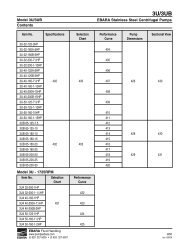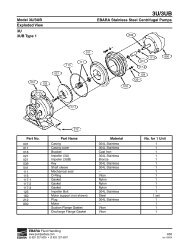Design Manual - International Wastewater Technologies
Design Manual - International Wastewater Technologies
Design Manual - International Wastewater Technologies
You also want an ePaper? Increase the reach of your titles
YUMPU automatically turns print PDFs into web optimized ePapers that Google loves.
6.0 Inletting the Chambers<br />
Figure 7 – StormTech Isolator TM Row Detail<br />
CATCH<br />
BASIN<br />
OR<br />
MANHOLE<br />
SUMP<br />
DEPTH BY<br />
DESIGN<br />
ENGINEER<br />
SC-740 – 24'' (600 mm) PIPE<br />
SC-310 – 12'' (300 mm) PIPE<br />
INSPECTION PORT<br />
LOCATION PER ENGINEER'S<br />
DRAWING<br />
sediments and protects the stone base during maintenance.<br />
A strip of non-woven AASHTO M288 Class 2<br />
geotextile is draped over the Isolator chamber row. This<br />
6-8 oz. (217-278 g/m 2 ) non-woven filter fabric prevents<br />
sediments from migrating out of the chambers perforations<br />
while allowing modest amounts of water to flow out<br />
of the Isolator Row. Figure 7 is a detail of the Isolator<br />
Row that shows proper application of the geotextiles.<br />
Inspection is easily accomplished through the upstream<br />
manhole or optional inspection ports. Maintenance of an<br />
Isolator Row is fast and easy using the JetVac process<br />
through the upstream manhole. Section 13.0 explains the<br />
inspection and main tenance process in more detail.<br />
Each SC-740 chamber in an Isolator Row will store 45.9 ft 3<br />
(1.3 m 3 ) of first-flush stormwater. During and between<br />
storm events an Isolator Row will allow stormwater to<br />
egress at a rate of 0.25 cfs (7.1 l/s) or less per chamber.<br />
A bed of StormTech chambers may have multiple Isolator<br />
Rows to accommodate required first-flush volumes.<br />
6.4 ECCENTRIC MANIFOLD SYSTEM – TREATMENT TIER 3<br />
The third tier of the treatment train is the eccentric manifold<br />
system. This is much like a typical manifold system<br />
except that the inlet pipe stubs are smaller and located<br />
at a higher invert than the main trunk of the manifold.<br />
This is accomplished by building the manifold system<br />
with reducer tees installed upside down so a “sump” is<br />
created within the large dia meter header pipe as shown<br />
in Figure 8. A typical eccentric system might have a 48"<br />
(1200 mm) pipe with 18" (450 mm) manifolds creating a<br />
30" (750 mm) header sump.<br />
The upstream end of the eccentric manifold system will<br />
typically be connected directly to the downstream side of<br />
the Isolator Row’s weired manhole as shown in Figure 6.<br />
Pipe companies can provide more detailed information on<br />
designing a header system optimized for trapping TSS.<br />
COVER ENTIRE ROW WITH AASHTO M288<br />
CLASS 2 NON-WOVEN GEOTEXTILE<br />
SC-740 — 8' (2.4 m) WIDE STRIP<br />
SC-310 — 5' (1.5 m) WIDE STRIP<br />
2 LAYERS OF WOVEN GEOTEXTILE THAT MEETS AASHTO M288 CLASS 1<br />
REQUIREMENTS, BETWEEN STONE BASE AND CHAMBERS<br />
SC-740 — 5' (1.5 m) WIDE STRIP<br />
SC-310 — 4' (1.2 m) WIDE STRIP<br />
Figure 8 – Typical Eccentric Header System<br />
HEADER PIPE<br />
MANHOLE<br />
MANIFOLD PIPES<br />
STORMWATER<br />
CHAMBERS<br />
STORMTECH<br />
ENDCAP<br />
6.5 TREATMENT TRAIN CONCLUSION<br />
The treatment train is a highly effective water-quality<br />
approach that does not add significant cost to a StormTech<br />
system being installed under commercial parking areas.<br />
The StormTech Isolator Row adds a significant level<br />
of treatment, easy inspection and maintenance, while<br />
maintaining storage volume credit for the cost of a<br />
modest amount of geotextile. Finally, a pipe manifold<br />
system is a well recognized component of a chamber<br />
inlet system. Inverting the reducer tees creates an<br />
eccentric manifold system that can be easily inspected<br />
and maintained. This treatment train concept provides<br />
three levels of treatment, inspection and maintenance<br />
upstream of the StormTech detention/retention bed<br />
with little additional expense.<br />
6.6 OTHER INLET OPTIONS<br />
While the three-tiered treatment train approach is the<br />
recommended method of inletting StormTech chambers<br />
for typical under-commercial parking applications, there<br />
are other effective inlet methods that may be considered.<br />
For instance, Isolator Rows, while adding an inexpensive<br />
level of confidence, are not always necessary. A<br />
header system with fewer inlets can be designed to further<br />
minimize the cost of a StormTech system. There may<br />
be applications where stormwater pre-treatment may not<br />
be necessary at all and the system can be inlet directly<br />
from the source. Contact StormTech’s Technical Service<br />
Department to discuss inlet options.<br />
Call StormTech at 860.529.8188 or 888.892.2694 or visit our website at www.stormtech.com for technical and product information. 11





